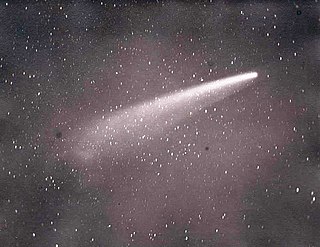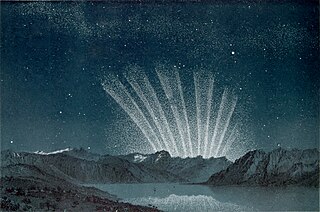
Comet Hale–Bopp is a long-period comet that was one of the most widely observed of the 20th century and one of the brightest seen for many decades.

Comet Ikeya–Seki, formally designated C/1965 S1, 1965 VIII, and 1965f, was a long-period comet discovered independently by Kaoru Ikeya and Tsutomu Seki. First observed as a faint telescopic object on 18 September 1965, the first calculations of its orbit suggested that on October 21, it would pass just 450,000 km (280,000 mi) above the Sun's surface, and would probably become extremely bright.

Comet Encke, or Encke's Comet, is a periodic comet that completes an orbit of the Sun once every 3.3 years. Encke was first recorded by Pierre Méchain on 17 January 1786, but it was not recognized as a periodic comet until 1819 when its orbit was computed by Johann Franz Encke. Like Halley's Comet, it is unusual in its being named after the calculator of its orbit rather than its discoverer. Like most comets, it has a very low albedo, reflecting only 4.6% of the light its nucleus receives, although comets generate a large coma and tail that can make them much more visible during their perihelion. The diameter of the nucleus of Encke's Comet is 4.8 km.

Comet West, formally designated C/1975 V1, 1976 VI, and 1975n, was a comet described as one of the brightest objects to pass through the inner Solar System in 1976. It is often described as a "great comet."

A sungrazing comet is a comet that passes extremely close to the Sun at perihelion – sometimes within a few thousand kilometres of the Sun's surface. Although small sungrazers can completely evaporate during such a close approach to the Sun, larger sungrazers can survive many perihelion passages. However, the strong evaporation and tidal forces they experience often lead to their fragmentation.

The Great Comet of 1843, formally designated C/1843 D1 and 1843 I, was a long-period comet which became very bright in March 1843. It was discovered on February 5, 1843, and rapidly brightened to become a great comet. It was a member of the Kreutz Sungrazers, a family of comets resulting from the breakup of a parent comet into multiple fragments in about 1106. These comets pass extremely close to the surface of the Sun—within a few solar radii—and often become very bright as a result.

The Great Comet of 1882, formally designated as C/1882 R1, 1882 II, and 1882b, was a comet which became very bright in September 1882. It was a member of the Kreutz Sungrazers, a family of comets which pass within 1 R☉ of the Sun's photosphere at perihelion.
The Kreutz sungrazers are a family of sungrazing comets, characterized by orbits taking them extremely close to the Sun at perihelion. At the far extreme of their orbits, aphelion, Kreutz sungrazers can be a hundred times farther from the Sun than the Earth is, while their distance of closest approach can be less than twice the Sun's radius. They are believed to be fragments of one large comet that broke up several centuries ago and are named for German astronomer Heinrich Kreutz, who first demonstrated that they were related. These sungrazers make their way from the distant outer Solar System to the inner Solar System, to their perihelion point near the Sun, and then leave the inner Solar System in their return trip to their aphelion.
Comet White–Ortiz–Bolelli was a bright comet which appeared in 1970. It was a member of the Kreutz sungrazers, a family of comets which resulted from the break-up of a large parent comet several centuries ago. It was already easily visible to the naked eye when first discovered, and reached a maximum apparent magnitude of +1.

Comet Pereyra was a bright comet that appeared in 1963. It was a member of the Kreutz Sungrazers, a group of comets that pass extremely close to the Sun.

13P/Olbers is a periodic comet with an orbital period of 69 years. It fits the classical definition of a Halley-type comet with a period between 20 and 200 years. The comet last passed perihelion 30 June 2024 and it was previously seen in 1956. The next perihelion is in 2094.
20D/Westphal was a periodic comet with an orbital period of 61 years. It fits the classical definition of a Halley-type comet. The comet appeared to disintergrate during the 1913 apparition and hasn't been observed since then.

Comet 96P/Machholz or 96P/Machholz 1 is a short-period sungrazing comet discovered on May 12, 1986, by amateur astronomer Donald Machholz on Loma Prieta peak, in central California using 130 millimetres (5.1 in) binoculars. On June 6, 1986, 96P/Machholz passed 0.404 AU from the Earth. 96P/Machholz last came to perihelion on January 31, 2023. The comet has an estimated diameter of around 6.4 km (4.0 mi).

The Great Comet of 1744, whose official designation is C/1743 X1, and which is also known as Comet de Chéseaux or Comet Klinkenberg-Chéseaux, was a spectacular comet that was observed during 1743 and 1744. It was discovered independently in late November 1743 by Jan de Munck, in the second week of December by Dirk Klinkenberg, and, four days later, by Jean-Philippe de Chéseaux. It became visible with the naked eye for several months in 1744 and displayed dramatic and unusual effects in the sky. Its absolute magnitude – or intrinsic brightness – of 0.5 was the sixth highest in recorded history. Its apparent magnitude may have reached as high as −7, leading it to be classified as a Great Comet. This comet is noted especially for developing a 'fan' of six tails after reaching its perihelion.
D/1770 L1, popularly known as Lexell's Comet after its orbit computer Anders Johan Lexell, was a comet discovered by astronomer Charles Messier in June 1770. It is notable for having passed closer to Earth than any other comet in recorded history, approaching to a distance of only 0.015 astronomical units, or six times the distance from the Earth to the Moon. The comet has not been seen since 1770 and is considered a lost comet.

C/2011 L4 (PanSTARRS), also known as Comet PANSTARRS, is a non-periodic comet discovered in June 2011 that became visible to the naked eye when it was near perihelion in March 2013. It was discovered using the Pan-STARRS telescope located near the summit of Haleakalā, on the island of Maui in Hawaii. Comet C/2011 L4 probably took millions of years to come from the Oort cloud. After leaving the planetary region of the Solar System, the post-perihelion orbital period is estimated to be roughly 107000 years. Dust and gas production suggests the comet nucleus is roughly 1 kilometer (0.62 mi) in diameter, while based on the absolute nuclear magnitude and a geometric albedo of 0.04 the diameter of the nucleus is over 2.4 kilometers (1.5 mi). A method based on coma magnitude decay function estimated the effective radius at 2.317 ± 0.190 km.

Comet Lovejoy, formally designated C/2011 W3 (Lovejoy), is a long-period comet and Kreutz sungrazer. It was discovered in November 2011 by Australian amateur astronomer Terry Lovejoy. The comet's perihelion took it through the Sun's corona on 16 December 2011, after which it emerged intact, though greatly impacted by the event.

The Great Southern Comet of 1865, also known as C/1865 B1 by its modern nomenclature, was a non-periodic comet, which in 1865 was so bright that it was visible to unaided-eye observations in the Southern Hemisphere. The comet could not be seen from the Northern Hemisphere.

The Great Southern Comet of 1880, formally designated as C/1880 C1 in modern nomenclature, is a comet that became visible in the naked eye throughout the Southern hemisphere in February 1880. It is notable for being classified as a "great comet" not by its apparent magnitude, but by its prominent tail.
Comet du Toit, formal designation C/1945 X1, is a sungrazing comet that was observed four times by South African astronomer, Daniel du Toit, on December 1945. The comet is a member of the Kreutz sungrazer family.

















